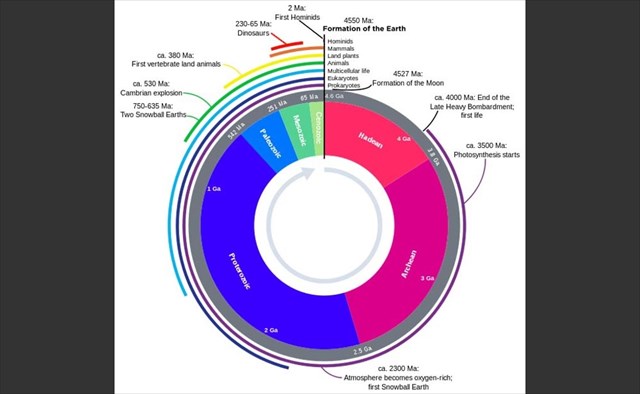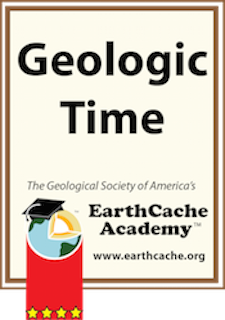
A. Introduction:
At this waypoint you will be at the start of the Barberton geotrial. You have to complete the Barberton gelogical trail to be able to answer and to complete this EC. There is no traditional container to be found at this point. On this geological trail you will experience one of the oldest places on earth. To appreciate the age of the geological formations, we need to quantify geological time to understand the time significance of the geological formations. The best way to describe time is the geological time scales. It will give you an idea of how old the examples are.
B. Geological Time Frames
Geological time frames are expressed as ….. Eon – Era – Period – Epoch – Age.
This time scale above is from large to smaller. With other words here we will express a certain time span in a Eon, we will then subdivide it in Era which is a smaller part, each of the Era parts will be subdivided in a period, each period will be subdivided down in a Epoch period and each Epoch period will be subdivided in a age. Every time scale presents a significant geological event. Our focus will be on the super eon called Precambrian which contains about 88% of our geological history. The development of the human race, from the beginning to Homo Sapiens, only describes 0.03% of the the life of our planet.
The Precambrian is usually considered to have three eons: the Hadean, the Archean and the Proterozoic. Some scientists recognize a fourth eon, which they call the Chaotian, which predates the others and is the time of the first formation of our solar system. In the Chaotian eon we can go back to the beginning of the universe which is calculated as 13.8 billion years old. NASA’s Wilkinson Microwave Anisotrophy Probe provided this evidence.
The Precambrian is the name given for the first super eon of Earth’s history. This division of time — about seven-eighths of Earth's history — lasted from the first formation of the planet (about 4.6 billion years ago) to the geologically sudden diversification of multicellular life known as the Cambrian Explosion (usually dated at about 542 million years ago).

B.1 Hadean Eon
The Hadean is the geological time period during which Earth formed, from the start of the solar system (4.6 billion years ago) until accretion, impact, and local melting led to stable Earth-Moon orbits and the oldest Earth rocks (3.8 billion years ago).
The Hadean Eon occurred 4.6 billion to 4 billion years ago. It is named for the mythological Hades, an allusion to the probable conditions of this time. During Hadean time, the solar system was forming within a cloud of dust and gas known as the solar nebula, which eventually spawned asteroids, comets, moons and planets. This early crust was frequently turned and subsumed by the molten interior. There are few terrestrial rocks from Hadean time, just a few mineral fragments found in sandstone substrates in Australia. However, study of lunar formations shows that the Earth/moon system continued to be bombarded by frequent asteroid collisions throughout the Hadean.

B.2 Archean Eon
The Archean eon, which preceded the Proterozoic eon, spanned about 1.5 billion years and is subdivided into four eras: the Neoarchean (2.8 to 2.5 billion years ago), Mesoarchean (3.2 to 2.8 billion years ago), Paleoarchean (3.6 to 3.2 billion years ago), and Eoarchean (4 to 3.6 billion years ago). Between 4 billion and 2.5 billion years ago, the continental shield rock began to form. Approximately 70 percent of continental landmass was formed during this time. Small “island” land masses floated in the molten “seas.” Earth had acquired enough mass to hold a reducing atmosphere composed of methane, ammonia and other gases. Water from comets and hydrated minerals condensed in the atmosphere and fell as torrential rain, cooling the planet and filling the first oceans with liquid water.
During the period between 3.8 and 2.5 bya, the Earth's atmosphere comprised methane, ammonia, and other gases which would be toxic to most life on our planet today. The Earth's crust continued to cool, and rocks and continental plates began to form. It is thought that life first formed during this period. The oldest known fossils are bacterial micro fossils that roughly date to 3.5 billion years ago.
Exactly when or how it happened is unknown, but micro fossils of this time indicate that life began in the oceans about 3.5 billion to 2.8 billion years ago. It is probable that these microscopic prokaryotes began as chemoautotrophs, anaerobic bacteria able to obtain carbon from carbon dioxide (CO²). By the end of the Archean, the ocean floor was covered in a living mat of bacterial life.
It was early in the Archean that life first appeared on Earth. Our oldest fossils date to roughly 3.5 billion years ago, and consist of bacteria micro fossils. In fact, all life during the more than one billion years of the Archean was bacterial. The Archean coast was home to mounded colonies of photosynthetic bacteria called stromatolites. Stromatolites have been found as fossils in early Archean rocks of South Africa and western Australia. Stromatolites increased in abundance throughout the Archean, but began to decline during the Proterozoic. They are not common today, but they are doing well in Shark Bay in Australia.

B.3 Proterozoic Eon
The Proterozoic eon, spanned about 1.5 billion years and is subdivided into three eras: the Neoproterozoic (1000 to 542.0 mya), Mesoproterozoic (1600 to 1000 mya) and Paleoproterozoic (2500 to 1600 mya).
The Proterozoic Eon is also called the Cryptozoic ("age of hidden life"). About 2.5 billion years ago, enough shield rock had formed to start recognizable geologic processes such as plate tectonics. Geology was about to be joined by biology to continue Earth’s progress from a molten hell to a living planet. It is generally accepted that different types of prokaryotic organisms formed symbiotic relationships. Some types, more efficient at converting energy, were engulfed by larger protective “bubbles” able to shield them from the harsh environment. As time went on the symbiotic relationship became permanent and the “energy conversion” components became the chloroplasts and mitochondria of the first eukaryotic cells. Micro fossils of these early cells are called Acritarchs.
Photosynthesis began to add oxygen to the atmosphere, putting pressure on organisms adapted to the reduction atmosphere of the early Earth.
After a brief ice age in the mid-Proterozoic, organisms underwent rapid differentiation. The Ediacaran Period , the last of the Proterozoic Era, saw the first multicellular organisms. Autotrophs and soft-bodied heterotrophs filled the continental shelf regions around Rodinia. Many were Cnidarians similar to small jellyfish with radial body symmetry and specialized cells to sting prey and convey it into the body cavity. Fossils show that significantly different populations inhabited different localities. Some sea bottom-dwelling organisms used a muscular “foot” to cling to the ocean bottom similar to the modern sea pen. Kimbrella fossils show a clear anterior/posterior axis, bilateral body symmetry and some indications they could crawl. Some scientists classify them as being related to the mollusks.
The boundary between the Ediacaran Period of the Proterozoic Era and the Cambrian Period of the Paleozoic Era is not as clear-cut as it was once thought to be. It used to be thought that increasing oxygenation caused a mass extinction of Ediacaran forms and a geologically sudden proliferation of new complex forms. Now it is understood that there were many complex multicellular animals capable of living in the higher oxygen of the Ediacaran environment. However they were nearly all soft-bodied forms, which left few fossil traces behind for us to find. The relative abundance of Cambrian fossils represents an increase in animals with calcified body parts, which were easily fossilized, not a mass extinction of Ediacaran life as was once thought.
C. To log this EarthCache you have to answer the following questions and e-mail the answers to the owner:
-
Theory. Identify the 3 eons contained in the Precambrian. Subdivide each eon into the correct eras. It will be easier to do this in a spreadsheet.
-
Practical. Note 3 different geological rock examples on this geological trail and/or which is mentioned on the info boards at the various locations and divide them in the correct eras as identified in question 1. Geological time is based on absolute time.
-
Practical. Please go to waypoint S25 54.372 E 31 06.078. You will notice an unusual geological feature. Take along a magnet and place it on the rock - what is the effect? This waypoint is not explained on the info boards. Apply your knowledge and guesstimate the possible era during which this one was formed. Why did you select this era?
Uploading photos to the cache page is the best way to say thank you to the cache developer and to encourage others to visit the location but it is only optional.
D. References:
E. NOTES:
-
There are no other facilities along the trail except for very nice picnic spots.
-
The distance is about 40km from Barberton on a narrow and winding road up to the Bulembu border post to Swaziland with no or limited cellphone reception.
-
You can email me your answers in either Afrikaans or English.
Note that a handy guidebook specially compiled for this route is on offer at Barberton Tourism in town.
Inquiries: 013-712 2880 or www.barberton.co.za Guided tours by Tony Ferrar on 072-376-2581 and Dave Mourant on 082-923-5366.
Thank you to the Barberton Chamber of Business and all those involved to develop this geotrail.


| I have earned GSA's highest level: |
 |
The following link will introduce you to a more comprehensive study with an interactive tool. You will learn a lot with this tool. Atmospheric composition, temperature, biodiversity, day length and solar luminosity over time can be visualized. Hope someone will value it.
Interactive Tool
